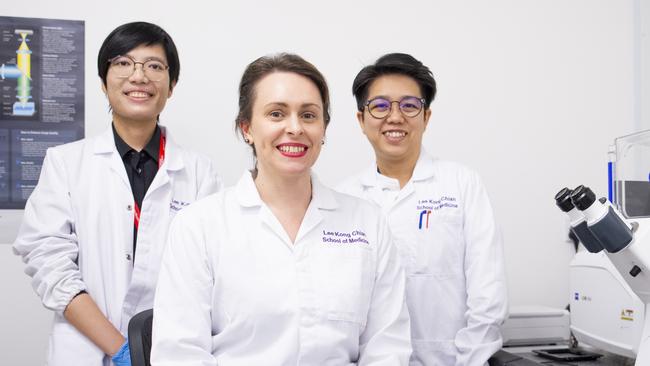Breakthrough research into brain ‘switch’ builds hope for new Alzheimer’s treatment
Anna Barron was always fascinated by neuroscience and her discovery of a ‘metabolic’ switch in the brain could unlock groundbreaking new treatments for Alzheimer’s.

Anna Barron was always fascinated by neuroscience, but it was the experience of watching her grandfather deteriorate from Alzheimer’s that steered the West Australian into dementia research and the discovery of a “metabolic” switch in the brain that could unlock groundbreaking new treatments for the disease.
Now Singapore-based, Assistant Professor Barron, 41, heads a team of researchers at Nanyang Technological University that has identified a way to stimulate the brain’s immune cells – or microglia – to more efficiently clear toxic waste linked to the most common form of dementia.
Their breakthrough research, published last month in the Proceedings of the National Academy of Sciences, centres on the discovery that by blocking and turning off a so-called energy switch, microglia are better able to remove toxic proteins that build up and lead to Alzheimer’s disease.
“At this stage, it is a basic science discovery,” Prof Barron said. “Our next step is the future development of potential drugs, which is a very long process.”
Still, the findings have raised keen global interest as scientists race to develop more effective treatments for a disease which already affects as many as one in 10 Australians over the age of 65.
The WHO predicts dementia will affect 78 million people worldwide by 2030, rising to 139 million by 2050.
Alzheimer’s is a disease that starts in the brain many years before symptoms show and is thought to be caused by a build-up in the brain of toxic proteins, known as beta amyloid, that damage and eventually kill nerve cells.
Microglia in the brains of people with Alzheimer’s also tend to be more damaged and thus less capable of “gobbling up” that toxic waste. The more beta amyloid in the brain, the more likely it is to switch into an attack response of rapid but inefficient energy production, further hampering the clearing process.
The NTU team’s breakthrough lay in proving you could kickstart the microglia’s function in the brains of mice with Alzheimer’s – and prevent it from switching into a less efficient mode – by blocking a sugar-metabolising enzyme from sticking to the energy-generating parts of the immune cells.
“These microglia cells have to produce large amounts of energy very, very quickly when they go into an attack response, so they switch to a rapid but inefficient production of energy mode which is useful for a sprint (like fighting infection) but not a marathon (like Alzheimer’s),” Prof Barron said.
“What we observed was that a key sugar metabolising enzyme was stuck all over the energy generating part of the cell when they were metabolising inefficiently.
“We could show that if you can remove this enzyme from the energy generating part of the cell you can then stimulate cells to clear up toxic waste again.”
Her team‘s findings from lab experiments – which resulted in a nearly 20 per cent improvement in the microglia’s ability to clear toxic waste – have opened the door to new drugs that specifically target the metabolism function of brain immune cells to treat Alzheimer’s.
There is currently no cure for Alzheimer’s, which attacks the part of the brain that controls thought, memory and language.
Some critical discoveries in recent years have led to disease-modifying drugs for Alzheimer’s, but those antibody-based therapies are expensive and can only be administered intravenously.
Prof Barron believes her team’s research could lead to cheaper, more convenient oral drug treatments. “There’s obviously a pressing need … You would be hard-pressed to meet anyone who doesn’t know somebody affected by Alzheimer’s disease,” she said.




To join the conversation, please log in. Don't have an account? Register
Join the conversation, you are commenting as Logout